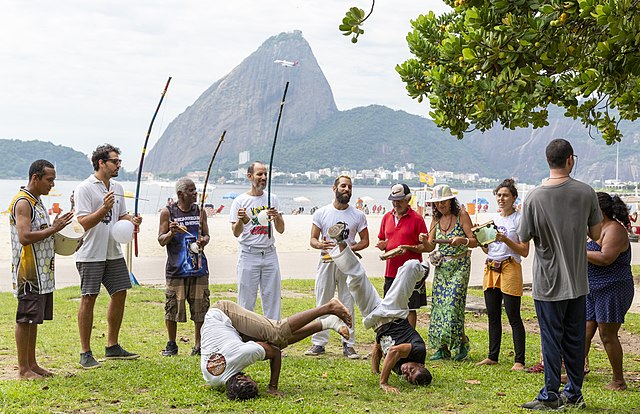The martial art capoeira is most common in Brazil and consists of music, dance, acrobatics and spirituality. Capoeira is an art that is constantly evolving and is known for its complex and acrobatic manoeuvres.
So, where did this unusual kind of martial art start and how did it develop?
Historically it is said that capoeira’s birth came among the slaves from West Africa which that the Portuguese colonists brought to Brazil during the 16th century. The martial art developed among the African slaves in the new countries in some kind of self-defence. When being banned from practising martial arts and honouring their culture, capoeira has helped bypass these laws. With the help of music and other elements, vicious punches and kicks were disguised as different kinds of dance movements. Capoeira became a survival instrument for the slave, not only as self-defence, but also as a cultural identity.
With the help of capoeira, many enslaved people escaped their persecutors and organized their own rebellion groups, the so-called quilombos – Brazilian slave settlement. These communities were often famous for the courageous defence they put up and capoeira was a vital part of their defence and cultural practice.
The dark time
During the 17th and early 18th centuries cities started to grow and the larger population in Brazil resulted in bigger groups of enslaved people in smaller areas. Even though capoeira was still being used for self-defence, it was mostly performed in competition and for entertainment. Despite this, the people that performed capoeira were still being punished for practising it.
The dark time for capoeira came with the ending of slavery in 1888, when there was widespread poverty. This caused criminality to increase massively and capoeira was one of the weapons used by criminals. This led to severe punishment in 1890 for those who carried out capoeira. From this era a man called Nascimento Grande was portrayed as a legend, as he was supposed to be invincible at capoeira.
The decriminalisation of capoeira
Despite the criminalisation of capoeira during the dark era, the unusual form of martial arts rekindled in popularity in the early 20th century and Mestre Bimba from Salvador drew attention to the cultural importance of capoeira and also made people realise how popular it was for tourists. Bimba managed to convince the authorities of the cultural value of the art form and opened the first capoeira school in 1932. The name of capoeira was not included in the name of the school though as it was still illegal. Bimba had a strict approach towards martial arts, which was called Regional. He created new movements and choreographed attacks.
In the 1940s the formal ban was lifted from capoeira, which led to two mainstreams developing side by side. It was Bimba’s Regional form and Angola, which put focus on the traditions of the art.
Capoeira today
Today Capoeira is part of Brazilian culture all over the world. Capoeira has grown across the globe and more than 150 different countries exercise it. Nowadays capoeira is performed in different contexts, all from entertaining choreographed dances to competitions where a contender tries to make his opponent fall out of time with the music. Capoeira is still popular for its basic martial arts and acrobatics. If you ever travel to Brazil, watching a capoeira performance is a must for many.
Lyssna på det senaste avsnittet av Fighterpodden!

Kommentarer